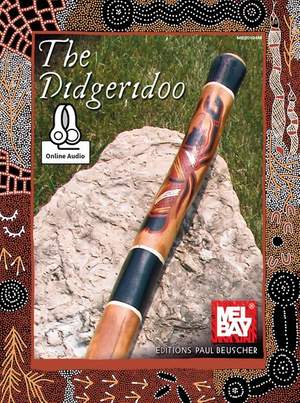
Didgeridoo, The
- Author: Beuscher, Paul
Sheet Music/Download
$27.50Contents
- 1. The Origin of the Didgeridoo
- 2. Testing, Appreciating, and Buying a Didgeridoo
- 2.1. If You Are Looking For Your First Didgeridoo
- 2.2. If You Already Have a Didgeridoo
- 2.3. Maintaining Your Didgeridoo
- 2.4. Transporting Your Didgeridoo
- 2.5. Repairing Your Didgeridoo
- 3. The Musical Qualities of a Didgeridoo
- 3.1. Its Musical Quality
- A. The Root Note
- B. The Basic Harmonic or ?2nd Note?
- C. The Overall Harmonic Richness: A Polyphonic Impression
- 3.2. The Timbre
- A. The Sound of a Tube
- B. The Nasal Sound
- C. Heavy Sound vs. Bright Sound
- D. Clear Sound vs. Resonant Sound
- 3.3. The Acoustic Qualities of the Didgeridoo
- A. Volume and Power
- B. The Spaciousness of the Sound
- 3.4. The Playing Potential
- A. Air Column Resistance (ACR)
- B. Playing Speed
- C. The Ability to Use Effects
- D. Ease of Playing
- 3.5. The Types of Didgeridoos
- 3.6. Summary: Criteria for Choosing a Didgeridoo
- PART II: PLAYING THE DIDGERIDOO
- 1. The Basics
- 1.1. Playing Position
- 1.2. Play from the Front or from the Side?
- 1.3. The Root Note
- 1.4. The Mouthpiece
- A. What Type of Wax Do We Use?
- B. How Do We Apply It?
- C. What Shape Do We Give the Mouthpiece?
- Some Forms of Mouthpieces
- 1.5. The Returning Sound
- 1.6. The First Tones
- A. The ?OO-EE?
- B. Positions Between ?OO? and ?EE?
- C. The Basic Rhythm Sounds
- D. The ?WOOAH?
- E. The Jump of the Kangaroo
- 2. Playing
- 2.1. Circular Breathing
- 2.2. Abdominal Breathing
- 2.3. Rhythm and the Rhythms
- 2.4. The Main Effects
- A. Singing
- B. Shouts
- C. High and Low Pressure
- D. Overtones
- E. The ?Oof!?
- 3. Further Development
- 3.1. Some Advice for Advancing
- 3.2. Building a Piece (Composing)
- 1) Starting
- 2) Continuing
- 3) And Finishing
- 3.3. Playing with Others
- 3.4. Accompaniment with Clap Sticks
- APPENDICES
- I. Didgeridoo Rhythms: Transcriptions of Didgeridoo Music
- II. Didgeridoo Discography


